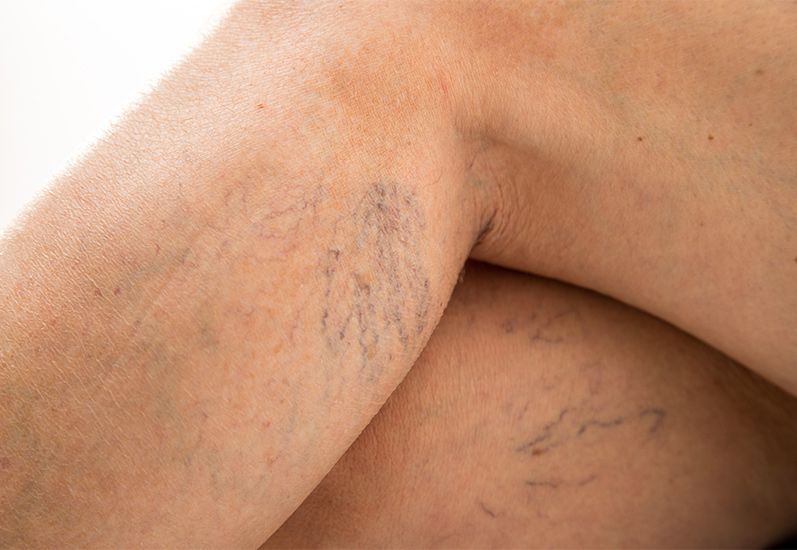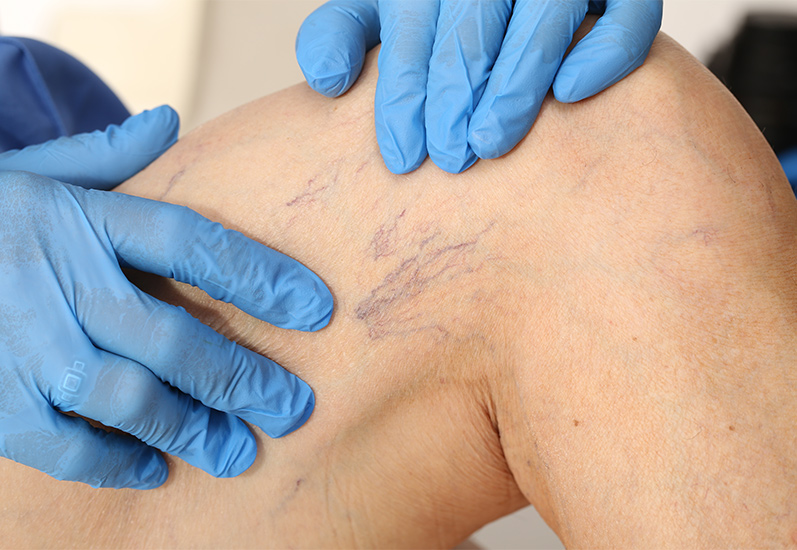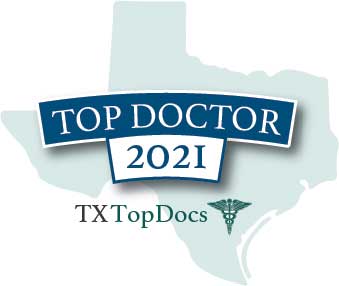Therapy For Spider Veins – Bring Out Your Best with Beautiful Skin
Our spider vein treatments are minimally invasive and proven to be extremely effective.
What Are Spider Veins?
Spider veins are abnormal tiny and irregular shaped blood vessels that form within the skin. They are usually red and purple in color but can also have a blue hue to them as well. Spider veins are typically around the size of a thread and are therefore also referred to as thread veins. Since they have an irregular linear and clustered appearance that can resemble a spider web, they are referred to as spider veins. A medical term for spider veins is telangiectasias. They can form on any part of the body, but they most commonly form on the legs and face. Genetics plays a predominant role in their formation. Small valves within certain skin veins weaken with aging, leading to spider vein formation. Spider veins dilate and enlarge and become increasingly more visible within the skin as the unsightly darkened veins form. Other factors such as trauma or excessive sun exposure can also cause these veins to develop. Certain conditions such as pregnancy and obesity can also make them worsen significantly.

Are Spider Veins Dangerous?
Spider veins are not dangerous. They usually do not lead to pain or symptoms. They are sometimes associated with mild pain that can be exacerbated by hormones or menstrual cycles. Although they do often multiply and spread as time passes, they do not turn into larger varicose veins. Spider veins do not tend to lead to any medical problems.
What Causes Spider Veins To Worsen and Spread?
Spider veins will worsen as you get older since our veins weaken with age. But spider veins do happen in young people as well, even teenagers can develop them. Certain situations will cause spider veins to worsen and spread, such as gaining too much weight as well as pregnancies. Lack of activity and a sedentary lifestyle can also cause spider veins to worsen. Prolonged standing or sitting without much movement will also accelerate the development of more spider veins. For example, if you are a hairstylist or bank teller and are on your feet all day on a hard floor your veins will tend to worsen more quickly. Untreated deeper veins such as varicose veins and reticular veins will also cause spider veins to worsen more quickly.
Prevention of Spider Veins
Since spider veins are an inherited genetic condition you will not be able to prevent them from forming if you are prone to them. But you can slow down how quickly spider veins develop and how severe they form. Some preventative tips are listed below:
- Wear supportive compression stockings. Prescription stockings obtained from a Vein Center will be more effective than typical over the counting compression stockings. The goal is to deliver between 20 mm Hg and 30 mm Hg Mercury of compression to the skin and the veins. This can only be accomplished with medically manufactured compression stockings that are produced by medical supply companies. Compression stockings obtained through a prescription tend to be more comfortable since a custom fitting is performed when purchasing this type of stocking. Multiple measurements are made from the ankle to the upper leg so that the stockings fit your legs properly. A proper fit translates into better prevention but also a more comfortable fit.
- Maintain a healthy active lifestyle with plenty of exercise.
- Maintain a normal weight.
- Avoid prolonged standing or sitting without movement.
- If you get pregnant, wear compression stockings throughout your pregnancy.
- Avoid excessive sun exposure and wear sunscreen.
- Do not let your spider vein get out of control. Spider veins often spread like weeds in a garden. If you keep the weeds out of your garden then the garden will stay healthy. Similar to spider veins! If you maintain your legs by seeing a vein specialist regularly and undergoing periodic vein treatments, then your legs will stay healthier and younger appearing throughout your life.

Treatment of Spider Veins
Spider veins are typically treated for cosmetic reasons. Since spider veins typically do not cause any symptoms, people are usually seeking treatment in order to improve the appearance of their skin. Spider vein removal is one of the most common cosmetic procedures performed worldwide.
There are two types of commonly performed procedures for spider vein removal. Sclerotherapy is the most common spider vein procedure. This procedure involves the injection of small quantities of medication into the spider veins with a very tiny needle. The skin and veins are magnified by magnification glasses and infrared lighting while the fine needle is inserted. The injected medication causes the small spider veins to collapse and fade. This magnification technique allows for more precise injections and therefore results in better cosmetic results. Saline injections were very common in the past. Currently new pharmaceuticals are used which are FDA approved and are very safe and effective.
The second most common procedure utilized for the treatment of spider veins is thermal ablation procedures. The most common indication for thermal treatments to be performed for spider veins is for telangiectasias that are located on the face.
These thermal treatments for spider veins can be performed with various types of thermal devices, including a vein laser, IPL (Intense Pulses Light), and Ohmic thermolysis (VeinGogh device). Your vein specialist would need to examine your veins in order to determine if one of these thermal treatments would be appropriate for your spider veins.
Many patients with spider veins also have additional defective veins just under the surface that are contributing to the development of their spider veins. These defective sub-dermal veins are referred to as reticular veins and they may be visible or invisible to the naked eye. Healthcare providers may also refer to reticular veins as “feeder veins” since they “feed” the smaller spider veins with abnormally high-pressure blood flow. Your vein specialist will need to carefully examine your skin to see if reticular veins are contributing to your problem. If reticular veins are present, then these veins will also need to be treated at the same time if you wish for your spider veins to resolve properly. Reticular veins put pressure on the skin and will cause spider veins to more readily form and spread. Reticular veins are best treated with sclerotherapy, but a stronger concentration of sclerotherapy medication is used for these types of veins since they are larger than spider veins.

Are Spider Vein Treatments Painful?
When performed by a Vein Specialist that is properly trained and experienced in spider vein therapy then the treatments will involve very little discomfort. But there are options available to minimize discomfort and anxiety related to the procedures if the patient desires. These options include premedication with a light oral sedative, topical numbing creams prior to the procedures, and cooling or icing of the areas. But we find that pre-medication is not necessary for the majority of patients.
Are Spider Vein Treatments Safe?
Spider vein therapies are very safe and effective when performed by a properly trained and experienced Vein Specialist. We find a very high level of patient satisfaction with spider vein treatments in our practice. The methods we utilize are all FDA approved. The risks of side effects or complications are low. We spend a lot of time counseling our patients about vein disease and about their particular treatment options. Our vein specialist will go over the treatment with you in detail before any treatment is performed. The risks, benefits, and alternatives of each treatment option will be discussed in detail before proceeding. We like to ensure that all of your questions are answered before moving forward with any cosmetic vein therapies.
To arrange a consultation with one of our specialists, please give us a call directly at (512) 220-5401 or send us a message via the online contact form.











